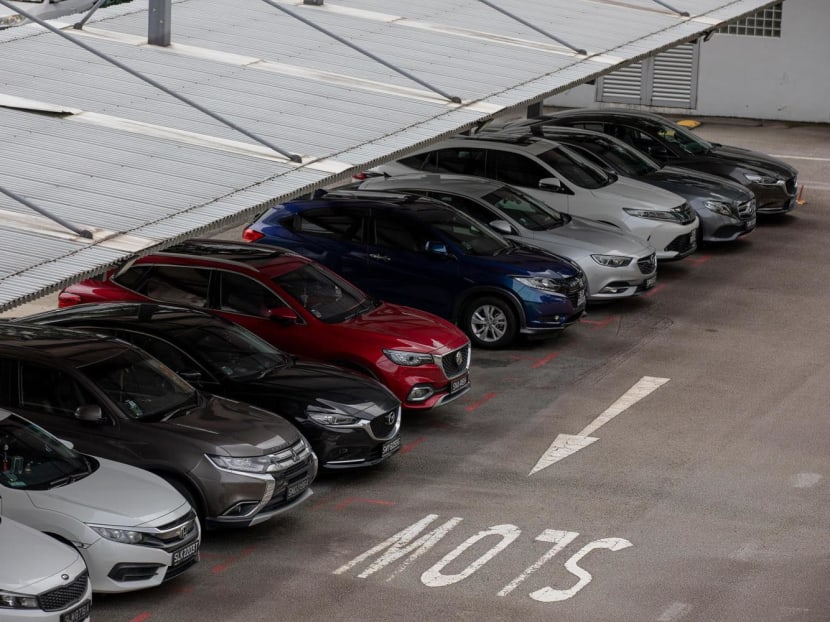5-year COEs due for deregistration to be brought forward in one-time move to increase Category A, B supply
SINGAPORE — In a bid to reduce the volatility of the quota for cars amid record-high Certificate of Entitlement (COE) prices, the Land Transport Authority (LTA) will bring forward and redistribute the supply of five-year COEs that are due to expire in the next projected supply peak.

While no absolute timeline to the redistribution was provided, Mr Iswaran said that many five-year COEs are expected to expire in "three, four years' time".
- The Land Transport Authority will bring forward and redistribute the supply of five-year Certificates of Entitlement that are due to expire
- Transport Minister S Iswaran announced this in Parliament during his ministerial statement on transport
- The move will increase the quota supply for small cars in Category A by 24 per cent, and large cars in Category B by 15 per cent for the remaining bidding exercises the May to July quarter
- Mr Iswaran said that the move will help to lessen, but not eliminate, the volatility in supply
SINGAPORE — In a bid to reduce the volatility of the quota for cars amid record-high Certificate of Entitlement (COE) prices, the Land Transport Authority (LTA) will bring forward and redistribute the supply of five-year COEs that are due to expire in the next projected supply peak.
This is a one-time move which will involve the redistribution of about 6,000 COEs over several quarters, starting from the May to July quarter.
For the next five bidding exercises that will run up to July, this will translate into a 24 per cent jump in quota supply for Category A, or smaller cars, while there will be a 15 per cent increase in supply for Category B, or bigger cars.
Transport Minister S Iswaran, who announced this in Parliament on Monday (May 8) during a ministerial statement on transport, said that the move will help to lessen, but not eliminate, the volatility in supply.
"There will still be a degree of supply fluctuation due to historical factors and broader market conditions," he said.
He added that the LTA is able to bring forward COE supplies as it can identify the exact number of such COEs expiring with certainty.
Car owners cannot further renew their vehicle's COE if they choose to renew it for five years after the first 10-year period.
While no absolute timeline to the redistribution was provided, Mr Iswaran said that many five-year COEs are expected to expire in "three, four years' time".
"That is where LTA is basically extracting the five-year COEs from and it will be redeployed in not just this quarter or the next quarter but in the next few quarters at least leading up to this," he said.
His ministerial statement, which reiterated the Government's stance on making Singapore a car-lite society, was in response to questions from 10 Members of Parliament on the recent record-high COE prices, with some asking if there are plans to review or alter the system to better allocate COEs.
Mr Iswaran also clarified that the five-year COEs of the cars will be allocated back to the same category. For example, if the COE is of a Category A vehicle, the reallocated COE will go towards boosting the Category A quota.
During the COE bidding result on April 19, the premiums for cars in Category A shot up for the first time past the S$100,000 mark to S$103,721, while COE prices for cars in Category B rose to S$120,889, setting new records.
The LTA said that the redistribution will start on May 15, with the COE quota rising from 9,575 to 10,431.
The COE quota for Category A will rise from 467 in the previous bidding exercise to 578 in the next exercise, and for Category B there will be an increase from 394 to 453.
Mr Iswaran explained that COE supply is determined primarily by car deregistrations in preceding quarters, which have "been relatively low of late".
He pointed out that the Government has already made several moves to reduce the volatility in quota supply.
For instance, LTA announced earlier this year that the number of COEs available for bidding in each quarter will be computed based on the rolling average of the number of vehicles deregistered over the previous four quarters, to mitigate quarter-on-quarter volatility.
He pointed out that the COE supply is also expected to "start increasing substantially" in the coming months as more cars reach the 10-year mark, which should ease the market.
But he cautioned that the long-term upward trend in COE prices "will not abate" due to rising incomes and zero vehicle population growth.
If one were to compare COE prices to median income, such prices are actually lower even though the absolute price is higher, because household income has risen, said Mr Iswaran.
"As household incomes continue to rise in the coming years, coupled with our policy of zero-growth in the car population, we must expect the long-term trajectory for COE prices to be upwards," he said.
"This is further accentuated or exacerbated by the fact that we are now at the trough in the 10-year cycle of COE supply," Mr Iswaran said.
He added that the demand in all COE categories has remained resilient, especially as the economy recovers from the Covid-19 pandemic.
NEEDS-BASED SYSTEM, PAY-AS-YOU-BID SUGGESTIONS
Several MPs responded to Mr Iswaran's ministerial statement by voicing their suggestions on how the Government can improve the COE system.
Bukit Panjang Single Member Constituency MP Liang Eng Hwa suggested that some COEs be allocated through a balloting system, such as what is done for public housing allocation, rather than the current bidding system.
Mr Iswaran responded by asking Mr Liang how such balloted COEs will be priced.
"If it's a discounted price, then it's a windfall for the party that gets this, because they will then be able to resell the car with the COE at a higher price because the market price is higher," said Mr Iswaran.
"Then the question is what justifies such a ballot? Who qualifies and how do we do it?"
Dr Lim Wee Kiak, Sembawang Group Representation Constituency MP, suggested a pay-as-you-bid system.
Mr Iswaran said that such a system may create a "great deal of variation in the market".
For instance, for the same car bought in the same exercise, the value could be different as one person bid higher and one bid lower.
"The issue is not the system of how it is being administered per se, the issue is really around supply and some level of volatility that we are trying to mitigate," he said.
Meanwhile, Non-Constituency MP Hazel Poa from Progress Singapore Party (PSP) asked if the Government will consider a point-based system which gives priority according to factors such as nationality, or needs as is the case with families with young children, elderly individuals, or persons with disabilities.
Mr Iswaran said that much like Mr Liang's idea of balloting, the decision to prioritise certain groups is "tricky" because the question of which group to allocate the points to "will be hard to answer".
He asked: "Does that mean that if someone has got more points, they're entitled to a different price when it comes to the COE? Or does it mean that they go into a different pool? And if they go into a different pool, how do we segment the pools?"
While he acknowledged that families with young children and elderly persons in the households will find it more convenient to have a car, this household make up covers "most households" here.
"So everyone has a need that I think we can understand. The real question for us is do we have the resources and the capacity to meet that need effectively? So that is where the challenge lies," he said.
NCMP Leong Mun Wai, who is also from PSP, asked if the Government would consider classifying cars not just on their engine capacity but also by their open market value as there are luxury cars that are now in the smaller car COE category.
To this, Mr Iswaran pointed out that the median OMV of Category B cars is about 75 per cent higher than the median of Category A cars, and so the markets are "already quite separated".
And while there are cases of "more expensive" car models being classified under Category A, there are also some mass market cars that are of higher engine capacities that are in Category B.











